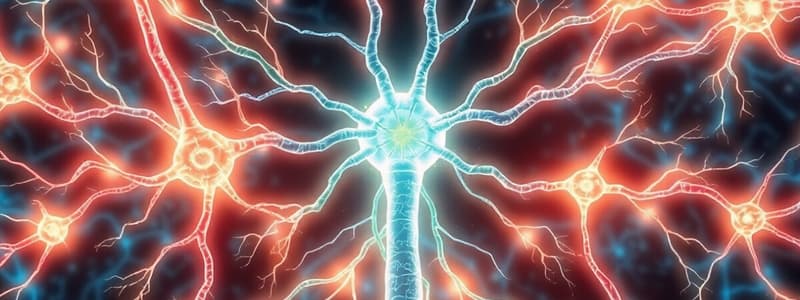Podcast
Questions and Answers
Which type of nerves carry messages from the brain to the muscles?
Which type of nerves carry messages from the brain to the muscles?
- Cranial Nerves
- Mixed Nerves
- Sensory Nerves
- Motor Nerves (correct)
What is the primary role of sensory nerves in the nervous system?
What is the primary role of sensory nerves in the nervous system?
- Conduct outgoing information to muscle cells
- Connect cranial nerves to the spinal cord
- Insulate axons for faster impulse transmission
- Transmit signals to the brain from sensory organs (correct)
Which cranial nerve is considered the longest?
Which cranial nerve is considered the longest?
- Vagus nerve (correct)
- Trochlear nerve
- Facial nerve
- Sciatic nerve
What type of nerve connects both sensory and motor functions?
What type of nerve connects both sensory and motor functions?
What feature distinguishes myelinated from non-myelinated nerves?
What feature distinguishes myelinated from non-myelinated nerves?
Which of the following is classified as a mixed nerve?
Which of the following is classified as a mixed nerve?
Which type of animal shows the most basic nervous system structure?
Which type of animal shows the most basic nervous system structure?
What is the structural and functional unit of the nervous system?
What is the structural and functional unit of the nervous system?
What is the primary role of Schwann cells in the nervous system?
What is the primary role of Schwann cells in the nervous system?
Which lobe of the cerebrum is primarily associated with visual processing?
Which lobe of the cerebrum is primarily associated with visual processing?
What is one function of neuroglial cells in the nervous system?
What is one function of neuroglial cells in the nervous system?
Which part of the brain is responsible for relaying sensory information?
Which part of the brain is responsible for relaying sensory information?
Which type of neuroglial cell is responsible for the formation of the myelin sheath?
Which type of neuroglial cell is responsible for the formation of the myelin sheath?
What functions are primarily associated with the frontal lobe of the cerebrum?
What functions are primarily associated with the frontal lobe of the cerebrum?
What is the function of the ependymal cells in the nervous system?
What is the function of the ependymal cells in the nervous system?
Which statement is true about the myelin sheath?
Which statement is true about the myelin sheath?
Flashcards are hidden until you start studying
Study Notes
Nervous System Overview
- The nervous system consists of nerves and neurons, which transmit signals throughout the body.
- Functions as the body’s electrical wiring.
Types of Nerves
- Sensory Nerves: Transmit messages from sensory organs to the brain.
- Motor Nerves: Carry messages from the brain to body muscles.
- Mixed Nerves: Combine functions of sensory and motor nerves, facilitating both incoming and outgoing information.
Classification by Connection
- Cranial Nerves: 12 pairs, originate from the brain, and convey messages to the rest of the body; include sensory and mixed types.
- Spinal Nerves: 31 pairs, originate from the spinal cord, and convey messages to and from the central nervous system; consist of mixed nerves.
Neurons
- Neurons are the structural and functional units of the nervous system.
- Typically remain in the G1 (Go) phase of the cell cycle and do not divide due to inactive centrosomes.
- Considered the longest cells in the human body, with lengths reaching up to 1 meter.
Unique Nervous System Facts
- Hydra showcases the basic nervous system in simpler organisms.
- Sciatic nerve is the largest nerve in the human body.
- The vagus nerve is the longest cranial nerve.
- The trochlear nerve is the smallest cranial nerve.
Myelinated vs Non-Myelinated Nerves
- Myelinated nerves have an insulating layer called myelin sheath, enhancing the speed and efficiency of nerve impulse transmission.
- Non-myelinated nerves lack this sheath, resulting in slower conduction.
- Nodes of Ranvier facilitate saltatory conduction by allowing impulses to jump between myelin sheaths.
Neuroglial Cells
- Specialized cells that support, protect, and nourish neurons. Types include:
- Astrocytes: Nutritional support between blood capillaries and neurons.
- Microglia: Engulf foreign bodies and bacteria.
- Oligodendroglia: Produce myelin sheath in the central nervous system.
- Ependymal Cells: Line the ventricles of the brain and spinal cord filled with cerebrospinal fluid (CSF).
- Schwann Cells: Produce myelin sheath in the peripheral nervous system.
Brain Structure
- Cerebrum: The largest part of the brain, divided into two hemispheres connected by the corpus callosum. Contains four lobes:
- Frontal Lobe: Involved in speech, planning, reasoning, and movement.
- Parietal Lobe: Manages movement, stimulus perception, and orientation.
- Occipital Lobe: Responsible for visual processing.
- Temporal Lobe: Associated with memory recognition, auditory stimuli, and speech.
Functions of the Cerbrum
- Engages in thinking, intelligence, consciousness, memory, and interpreting sensory information like touch, hearing, and vision.
Thalamus and Hypothalamus
- The thalamus relays sensory information from sense organs and plays a pivotal role in sensory processing.
Studying That Suits You
Use AI to generate personalized quizzes and flashcards to suit your learning preferences.




